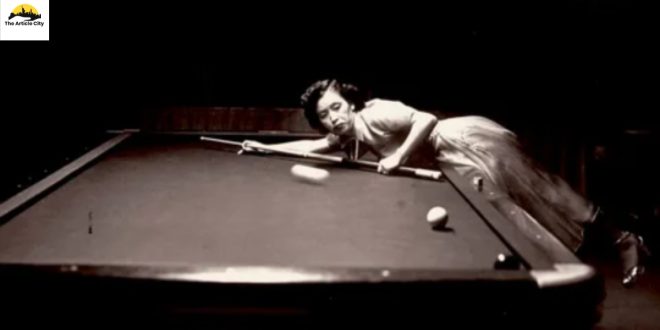If you’re a pool fan, you’ve seen Masako Katsura’s name before. She is the woman responsible for reinventing the game of pool as we know it, and she did it in a rather unconventional way. Born in Japan in 1928, Katsura was initially interested in mathematics and science. However, she quickly realized that mathematics wouldn’t help her achieve her goals.
That’s when she turned to the world of the pool—and she was blown away by what she found. The pool was a relatively new game, and Katsura saw potential. She began experimenting with different rules and setups, and soon enough, she had developed one of the most innovative pool games of all time. Her efforts paid off; today, Pool Masako Katsura is considered one of the greatest pool players. Read on to learn more about this fascinating woman and her revolutionary approach to the pool!
Background
Pool Masako Katsura is a Japanese professional pool player who has revolutionised the game by introducing new techniques and innovative plays. She first made a name for herself in the early 1990s, winning many tournaments and earning her place among the elite players in the world.
Katsura’s unorthodox playing style has been described as “chaotic”, but this unpredictability makes her so difficult to beat. Her goal is not to make simple shots but to create opportunities for her teammates, which often leads to spectacular photos that surprise opponents.
Although she has retired from competitive play, Katsura remains influential in the pool world and continues to share her knowledge and advice with other players. She has also served as the sport’s ambassador, helping promote the game abroad and introduce new fans to its exciting mechanics.
Early Years
Pool Masako Katsura was born in 1889 in the city of Kyoto. She loved playing with balls and posting up shots on makeshift tables in her backyard as a child. In 1916, at 24, Katsura became the first woman to win a world championship billiards tournament.
Katsura’s success as a billiards player paved the way for other women to participate professionally. Pool tournaments began to attract more vast and diverse crowds, which helped legitimize women’s participation in sports overall. Her impact on the game remains evident today – many modern pool tables are based on designs developed by Katsura.
The 1920s and 1930s
During the 1920s and 1930s, Pool Masako Katsura was one of the most influential players in billiards. She is credited with revolutionising the sport by inventing new shots and becoming one of its most successful practitioners. Katsura was born on December 21, 1892, in Nagoya, Japan. As a child, she showed an interest in billiards and learned how to play from her father.
In 1907, she travelled to Hong Kong to compete in a billiard tournament and won first prize. Shortly after this victory, she began travelling around Asia playing billiards tournaments. In 1921, she moved to the United States and began playing professional games there. She eventually became one of America’s top players and won several championships. In 1936, Katsura returned to Japan and retired from competition. She remained active in the game as a coach and promoter until her death on March 26, 1968.
The 1950s and 1960s
The 1950s and 1960s were a time of significant change in the world of pools. Masako Katsura, an influential player during this period, revolutionised the game by developing new techniques and playing strategies that have since become standard practice.
Katsura was born in 1933 in Miyagi Prefecture, Japan. She began playing pool early and quickly became one of the country’s best players. In 1953, she won her first major tournament, the Japanese Women’s Professional Championship.
In 1954, Katsura travelled to America to compete in the World Professional Billiards Championships. Her performance there led to a series of successful appearances on American television broadcasts. In 1955, she became the first woman ever to win a world championship title in any sport when she defeated Pat Ryan in the final of the World Professional Billiards Championship.
Later that year, Katsura won her second World Professional Billiards Championship title by defeating Willie Mosconi in the final. In 1957, she again won a world championship title when she defeated Manuel Rodriguez at the World Professional Billiards Championship Finals.
In 1960, Katsura retired from professional play to start a family but continued to work as a sports commentator and referee. She also served as president of the Japan Women’s Pool Union (1978-1981) and the International Pool Federation (1982-1986).
The 1970s and 1980s
In the 1970s and 1980s, Pool Masako Katsura revolutionised the sport of billiards by developing innovative techniques that allowed her to compete against men in international tournaments.
Her innovations include:
- Using two cue balls permitted her to make shots more consistently.
- The development of a spin move gives her an advantage over other players.
- The creation of new game variations that make playing pool more fun for spectators.
Katsura’s success has had a lasting impact on billiards, inspiring other female players to try their hand at professional competition. She has also helped to promote the pool as an entertaining and challenging activity for anyone who wants to join in.
The 1990s and 2000s
Pool Masako Katsura is credited with revolutionising the game of billiards in the 1990s and 2000s. Katsura is the first woman to win a world championship in the pool, and her innovative playing style has helped make her one of the most successful players in history.
Katsura was born on September 21, 1965, in Osaka, Japan. She started playing pool at a young age and quickly became interested in the sport. In 1988, she won her first world championship title, and over the next several years, she continued to dominate the competition. In 1993, she became the first woman to win a professional tournament by scoring more points than her opponent.
In 2001, Katsura was inducted into the World Professional Billiards and Crucible Association (WPBSA) Hall of Fame. In 2005, she was awarded an honorary membership in the WPBSA. She currently resides in Tokyo and continues to compete professionally.
The Future of Pool Masako Katsura
Pool Masako Katsura is a Japanese professional pool player who has become one of the most successful players in history. She has won over 100 international tournaments, including five world championships, and held the record for the most international wins by a female player until Itsuki Kunimatsu overtook her in 2012. Born in 1956, Katsura started playing pool at ten and quickly became a top player. In 1978 she made her professional debut and soon became one of Japan’s best-known players.
In 1984, Katsura entered her first world championship tournament and won four consecutive championships from 1986 to 1989. This success led to her being named world number one for the first time in 1990. She dominated the women’s game throughout the 1990s, winning nine more world titles between 1991 and 1998.
The men’s game noticed Katsura’s success, as she was invited to play in several high-profile events alongside some of the top male players. Her greatest challenge came at the 1992 World Championship when she faced American player Mike DeTernay in what was billed as ‘the battle of the century’. DeTernay had been tipped as one of the favourites for victory, but Katsura proved too strong for him, winning 3-2 in a closely contested match down to the final frame.
Conclusion
Pool Masako Katsura is one of the most influential figures in the history of billiards. Her innovations have profoundly impacted the game, and she has been credited with creating a modern pool, among other things. This article explores her life and how she influenced the billiards game. We also examine some of her significant accomplishments and discuss how important her work has been for both professional and amateur players. Thanks for reading!
 Posting Point
Posting Point

